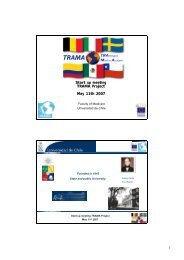(Microsoft PowerPoint - Roosvelt_Bogot\340)
(Microsoft PowerPoint - Roosvelt_Bogot\340)
(Microsoft PowerPoint - Roosvelt_Bogot\340)
You also want an ePaper? Increase the reach of your titles
YUMPU automatically turns print PDFs into web optimized ePapers that Google loves.
INSTITUTO DE<br />
ORTOPEDIA INFANTIL<br />
ROOSEVELT<br />
Dr José Luis Duplat<br />
Dr Iván Carlos Uribe<br />
Dr Luis Eduardo Rueda
Staff of the Lab<br />
<br />
<br />
<br />
<br />
Terapist<br />
<br />
<br />
<br />
Ing<br />
<br />
<br />
Claudia Gonzalez<br />
Magda Baquero<br />
Edna Perez<br />
Jorge Puentes<br />
Elsy Rodriguez<br />
Secretary<br />
<br />
Esperanza Mesa<br />
Pediatric Orthopaedic Surgeons<br />
<br />
<br />
<br />
<br />
Luis Eduardo Rueda<br />
Jose Luis Duplat<br />
Martha Valencia<br />
Ivan Carlos Uribe
Equipment<br />
BTS ELITE<br />
6 optoelectronic<br />
cameras<br />
3 video cameras<br />
2 AMTI force platforms,<br />
fixed on floor.<br />
Free EMG<br />
Baropodography
Equipment<br />
<br />
<br />
<br />
<br />
<br />
<br />
ELITE Clinic, Smart Tracker<br />
V1.0<br />
MyoLab<br />
Digivec<br />
FileMaker Pro Network<br />
Protocol: Davis<br />
Working in Upper Limb:<br />
Rab<br />
Foot protocol<br />
3 – 4 patients / day
Problems in the Lab<br />
Digivec software<br />
Free EMG config<br />
Work with platforms<br />
.dbt files, .tdf files
Effect of TRAMA project<br />
Research other fields than just gait<br />
Learning to use software we have<br />
Smart Analyzer<br />
Avoid square thinking
Hip extension osteotomy<br />
Lower limb multilevel surgery is used in<br />
cerebral palsy walking patients.<br />
Poor improving with: Sometimes worse<br />
after surgery.<br />
Hip flexion deformity.<br />
Anterior pelvic tilt.
Hip extension osteotomy<br />
Looking a modification in intertrochanteric<br />
osteotomy (2004) = add an extension<br />
effect.<br />
We want to evaluate the results with this<br />
technique up to now compared with the<br />
traditional intertrochanteric proximal<br />
femoral osteotomy.
Technique
Multilevel surgery<br />
(Proximal femur intertrochanteric rotation<br />
osteotomy)<br />
PREOP<br />
POSTOP
Multilevel surgery<br />
(Proximal femur intertrochanteric rotation<br />
osteotomy)<br />
PREOP<br />
POSTOP
QUESTION<br />
¿Is more effective the proximal femur<br />
extension osteotomy rather than the<br />
proximal femur rotation osteotomy to<br />
improve the hip flexion deformity in patients<br />
with cerebral palsy comparing Davis<br />
protocol parameters in gait analysis?
Selection criteria<br />
Patients with spastic cerebral palsy<br />
Be able to walk<br />
Previous proximal femur intertrochanteric<br />
surgery to improve hip flexion deformity<br />
Without intrapelvic psoas tenotomy
What we expect:<br />
Obtain a better active and pasive hip<br />
extension.<br />
Improve the pelvic tilt with extension<br />
osteotomy that let us to recomend the use<br />
to treat this deformity in cerebral palsy<br />
patients who are able to walk.
GENERAL AIM<br />
Evaluate the effect of the proximal femoral<br />
extension osteotomy to improve the hip<br />
flexion deformity, using the clinical<br />
evaluation and gait analisys in patients with<br />
spastic cerebral palsy treated at Roosevelt<br />
Institute since 2004.
SPECIFIC AIM<br />
1- Determinate the clinical improvement in hip<br />
flexion deformity meassuring preop and postop<br />
results<br />
2- Kinetic and Kinematic pelvic and hip behavior<br />
preop and postop using the HFI ( Hip Flexor<br />
Index )<br />
<br />
<br />
<br />
<br />
<br />
Rango tilt pelvico<br />
Tilt pelvico maximo<br />
Max extension cadera<br />
Tiempo crossover (momento)<br />
Poder H3
SPECIFIC AIM<br />
<br />
3 – Evaluate the changes in time and distance parameters<br />
with both surgery techniques<br />
<br />
4 –Deteminate if this correction obtained with this technique<br />
last in time.<br />
<br />
5 –Describe a surgical technique been able to reproduce it<br />
as an alternative to treat hip flexion deformity in patients with<br />
cerebral palsy.
TYPE OF STUDY<br />
Descriptive<br />
Case series comparation
DATABASE<br />
KINEMATICS
DATABASE<br />
KINETICS<br />
Cross Over<br />
Potencia de flexores
PRELIMINARY<br />
RESULTS
THOMAS SIGN<br />
AVERAGE<br />
RIGHT HIP:<br />
PREOP: 18 DEGREES<br />
POSTOP: 10.5 DEGREES<br />
LEFT HIP:<br />
PREOP: 14.28<br />
POSTOP: 12.85
PELVIC TILT<br />
AVERAGE<br />
Right hip:<br />
Preop:19<br />
Postop:15.4<br />
Left hip:<br />
Preop:20.3<br />
Postop:15.6
Multilevel surgery<br />
(Intertrochanteric rotation osteotomy)<br />
PREOP<br />
POSTOP
Multilevel surgery<br />
(Intertrochanteric extension osteotomy)<br />
PREOP<br />
POSTOP
Multilevel surgery<br />
(Intertrochanteric extension osteotomy)<br />
PREOPERATORIO<br />
POSTOPERATORIO
Working plan<br />
Complete data collection of the already<br />
included patients<br />
Increase the number of patients<br />
Apply the hip flexor index once completed<br />
the number of patients included.
Other Projects<br />
<br />
Ground reaction force vector<br />
Amputees<br />
Flat foot orthoses<br />
Upper limb<br />
Foot patology (Pes cavus, Talipes equinovarus)<br />
Foot alignment device<br />
Muscle length – OpenSim<br />
Technical protocols
THANK YOU






